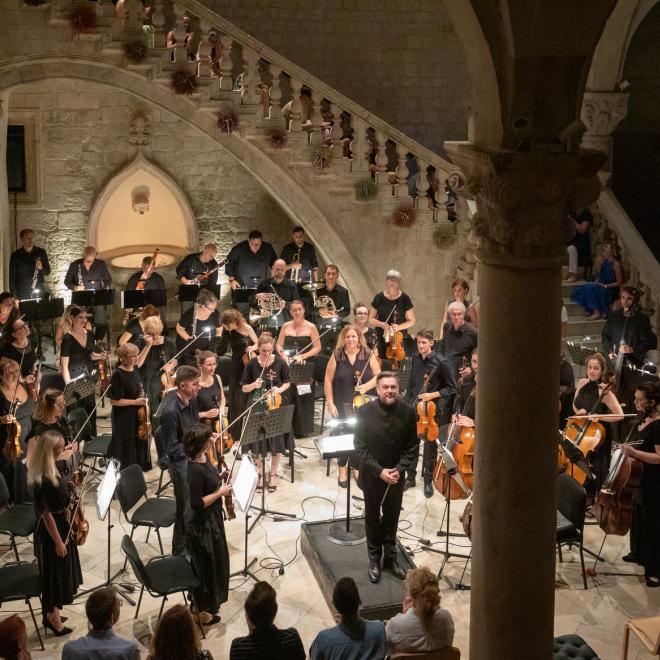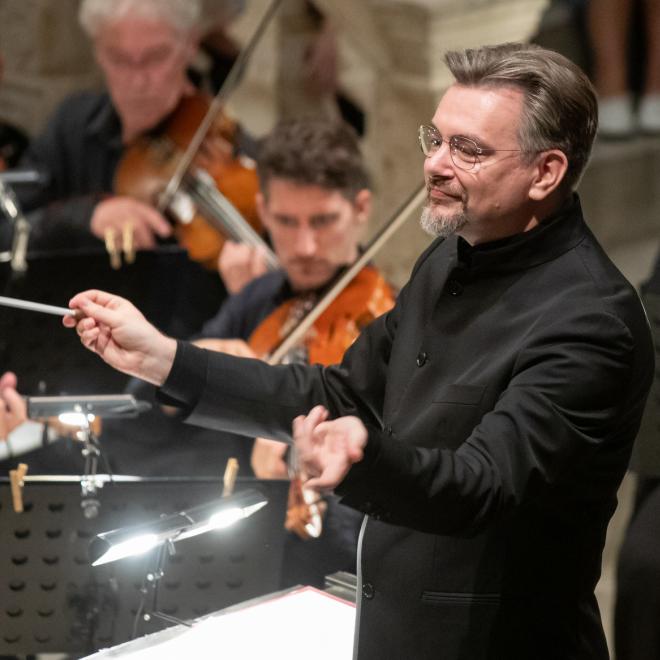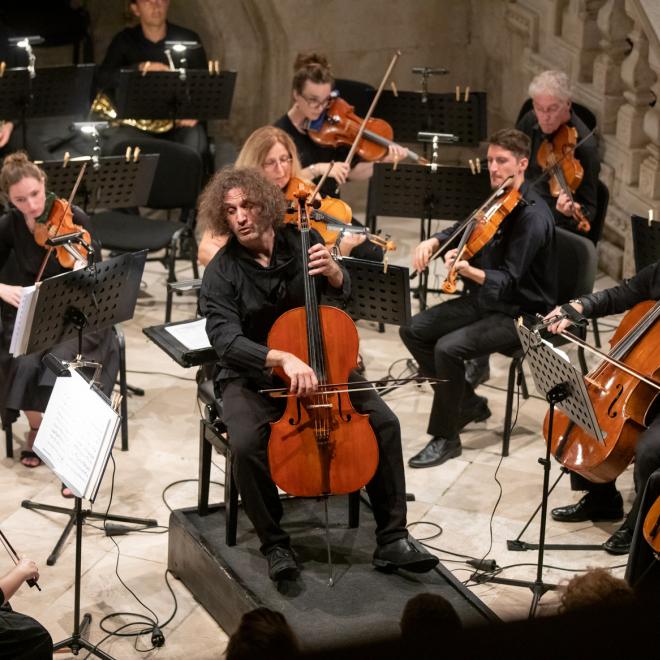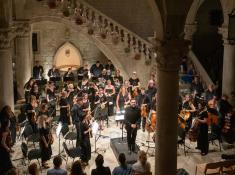 ,
,  ,
,  ,
, 
- More
- Performances
- Galleries
- Artists
Dubrovnik Symphony Orchestra
Pavle Zajcev, Conductor
Nicolas Altstaedt, cello
PROGRAMME:
Sergej Prokofjev: Symphony No. 1 in D major, Op. 25, "Classical"
Allegro
Larghetto
Gavotte: Non troppo allegro
Finale: Molto vivace
Joseph Haydn: Cello Concerto No. 1 in C major, Hob. VIlb:1
Moderato
Adagio
Finale: Allegro molto
***
Ludwig van Beethoven: Symphony No. 8 in F major, Op. 93
Allegro vivace e con brio
Allegretto scherzando
Tempo di Menuetto
Finale. Allegro vivace
--
MORE ABOUT THE PROGRAMME:
Notes by Dina Puhovski
Sergei Prokofiev (Sontsovka, today Krasne, 1891 – Moscow, 1953) received early music lessons from his pianist mother, studied with Glière, and with Lyadov and Rimsky-Korsakov at the Saint Petersburg Conservatory. Alongside composition, he studied piano and conducting and was awarded the Anton Rubinstein Prize for his graduation concert − a performance of his own piece, Piano Concerto No. 1. After his early collaboration with the choreographer Diaghilev in London, Prokofiev toured Japan and the USA, where he wrote his successful comic opera The Love for Three Oranges for the Chicago Opera. During the 1920s and early 1930s he was mostly based in Paris, composing prolifically, after which he returned to Moscow in 1936. His piece Peter and the Wolf was a huge success, as was his music for Sergei Eisenstein’s films. His opera War and Peace was premiered posthumously and, despite occasionally composing commissioned pieces written in the style of social realism, many of his works were banned from performance as ‘unsuitable’. He wrote seven symphonies, concertos, operas, ballets, cantatas, several chamber music works and numerous piano pieces.
He wrote his first, ‘Classical’ symphony during 1917, undisturbed by the revolutionary turmoil, according to his diaries. He wrote that he wanted to leave the city and ‘find some green spot where he could work and walk’, compose ‘without a piano’, like a true master. In the era of large-scale, grandiose symphonies, Prokofiev turned to classical composers, Mozart in particular, and wrote a playful, concise piece in which he infuses old forms with new harmonies and colours. He also wrote in his diary that classically inclined professors and musicians were bound to be appalled by it and imagined them saying, ‘look how he will not let even Mozart lie quiet in his grave but must come prodding at him with his grubby hands, contaminating the pure classical pearls with horrible Prokofievish dissonances.’
After three light movements, with a gavotte instead of a minuet, he found the finale he had initially written ‘too ponderous’. Inspired by the musicologist and composer Boris Asafyev, who told him that ‘there is no true joyfulness to be found in Russian music’, Prokofiev decided to write a new, lively and blithe movement filled with major triads. ‘I was hugging myself with delight all the time I was composing it!’ he wrote in his diary.
Franz Joseph Haydn (Rohrau, 1732 – Vienna, 1809) is one of the ‘Holy Trinity’ of Viennese Classicism, alongside Mozart and Beethoven. He was considered ‘the sanest and most balanced of composers’, according to the author Erik Tarloff, whose ‘intentions are always clear.’ Joseph Haydn spent thirty years in the service of the Esterházy family, where he found his answer to the common dilemma among composers: permanent employment and composing on demand or creative freedom and financial insecurity. Before his employment at the Esterháza estate, spanning from 1761 to 1790, Haydn was a highly esteemed independent composer in Vienna, where he was also exceptionally prolific: his output includes 104 symphonies, 83 string quartets and 32 pieces for mechanical clock (Flötenuhr, table or larger ornamental clock containing mechanical organ, the sound of which could be ‘programmed’).
Among other things, Haydn was expected to write concertos for the members of the court orchestra: He wrote Cello Concerto No. 1, in C major, Hob. VIIb:1, for his longtime friend and godson, Joseph Franz Weigl, cellist of the Esterháza Orchestra. He added oboes and horns to the string orchestra and separated the oboe part from the violin. The concerto consists of the rhythmical first movement, with a ritornello theme, the serene, lyrical second movement, and the finale that gave Weigl, known for his tone and virtuosity, the opportunity to show his technical prowess.
The piece was considered lost until 1961, when it was discovered in Prague by the musicologist Oldřich Pulkert. The identification was helped by the fact that Haydn regularly compiled lists of his works and musical themes. The twentieth-century premiere of the concerto was performed by the Czechoslovak Radio Symphony Orchestra with soloist Miloš Sádlo, conducted by Charles Mackerras, in 1962.
Haydn was Ludwig van Beethoven’s (Bonn, 1770 – Vienna, 1827) teacher for some time, when Beethoven came to Vienna from Bonn for the second time, in 1792, and stayed there. It seems that the two did not get along and that Haydn was too preoccupied with other commitments, Beethoven even said that he had not learned anything from Haydn. Allegedly, he also resented his teacher for criticising his Piano trio, Op. 1 No. 3, but soon after he dedicated his Sonatas, Op. 2, to Haydn.
A representative of Viennese Classicism, but on the border between classicism and romanticism, a symbol of an artist who stays true to his principles even in difficult circumstances, Beethoven was, according to Yehudi Menuhin, ‘a giant, inscrutable to most mortals due to his uncompromising power and unobsequious approach to music and people.’
Renowned for his piano skills, young Beethoven was supported by his friends, members of the aristocracy, to whom he often dedicated his works. He started experiencing problems with his hearing as early as 1795, and eventually had to give up public performances, but he compensated for his subsequent isolation with exceptionally developed musical imagination and high technical standards. His musical output is traditionally divided into three periods: the first, which ended around 1802, when he went through a crisis due to loss of hearing and uncertain future, the middle period, in which he wrote ambitious, ‘heroic’ works, and the third period from around 1815, considered more ‘spiritual’, meditative. Franz Liszt named these three periods simply l'adolescent, l'homme, le dieu (youth, man, god).
The Eighth out of Beethoven’s nine legendary symphonies, which laid the foundation for our understanding of this music form, often remains in the shadow of the composer’s more popular works. After grand and, for that time explosive works, in this symphony Beethoven went back to his roots to some extent, to smaller-scale forms, Haydn’s legacy. He probably wrote his first sketches thinking that he would write a piano concerto, but ended up writing a symphony in F major, in Linz in 1812. What is unusual about this work is that the orchestra immediately jumps into the main theme, without introduction or preparation; the theme is later expanded with dotted rhythm, leaps, rhythmic play that characterizes the entire work. There is no usual slow movement, instead there is an Allegretto scherzando, which, due to the ‘ticking’ of the sixteenth notes, was considered to parody the metronome, but this device came into use later, in 1815. Given the return to symphonic traditions, it is not surprising that the third movement is a Minuet, with ländler dance in its central part. After the relatively more ‘restrained’ first three movements, the Finale somewhat surprises with its growth, racing to fortissimo and triumph. When the composer Carl Czerny asked his friend Beethoven why his Eighth Symphony was less popular than the Seventh, Beethoven replied: ‘Because it is much better.’
--
Photo Nicolas Altstaedt (c) Marco Borggreve
--
- 02. August 2023./ Wednesday / 21:00 Rector's Palace Atrium +Tickets




